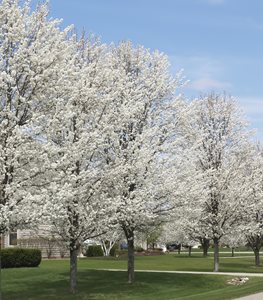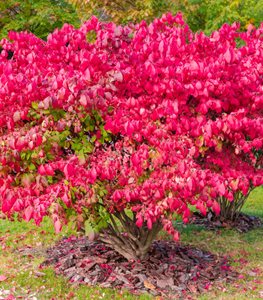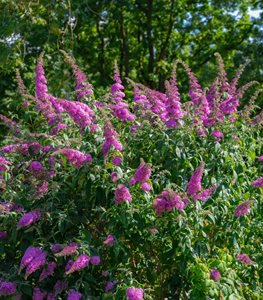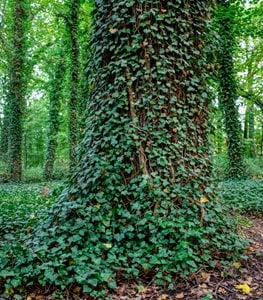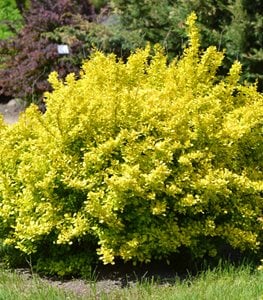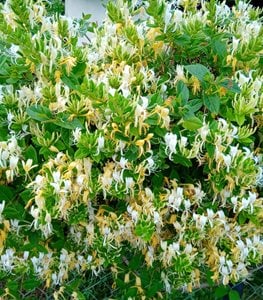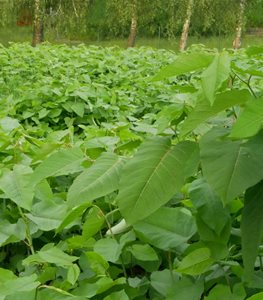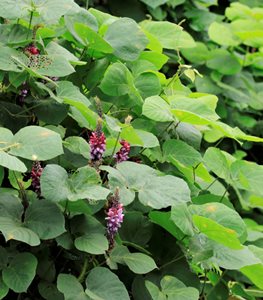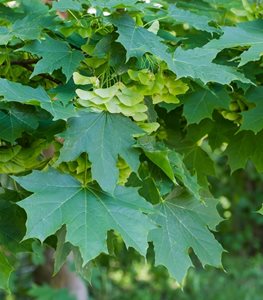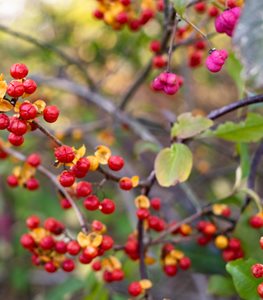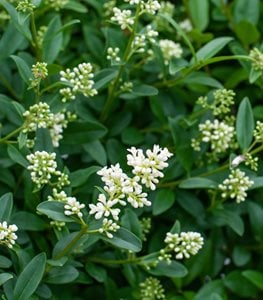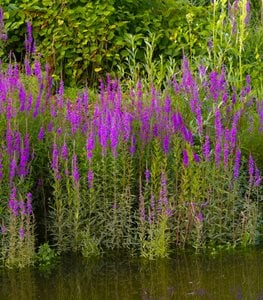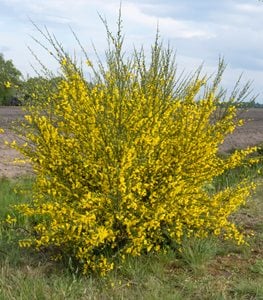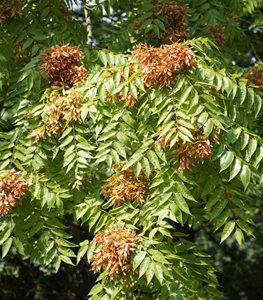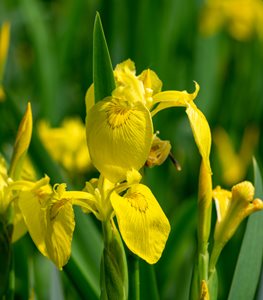INVASIVE PLANTS & WHAT TO GROW INSTEAD
Reduce problems in your landscape by eliminating invasive plantsOne of the greatest challenges gardeners face is controlling unwanted plants. Weeds and other problematic plants are introduced into garden areas in a number of ways. Seeds can be carried on wind currents or transported by wildlife. Dormant seeds buried underneath the soil may sprout when soil is disturbed through tilling or digging. Some garden plants have an aggressive growth habit and need to be controlled so they don’t displace other plants.
Invasive plant species have become a bigger problem in recent years with increased development, shrinking natural habitats and a changing climate. Many plants introduced from other regions of the world have displaced native species, upsetting local ecosystems.
Gardeners can do their part by keeping weeds under control and not planting invasive species. Learn more about some of the most invasive plants, and what to plant instead.
WHAT IS AN INVASIVE PLANT?
According to the United States Department of Agriculture (USDA), a species is invasive if it is non-native to the ecosystem and causes economic or environmental harm.
During the time of colonization in the U.S., plants were imported from all over the world, primarily in the 1700s and 1800s. Most of these plants including ornamentals, edibles, street trees, and landscape shrubs are not invasive. However, some of these non-native plants escaped cultivation and have naturalized in forests, fields, open woodlands, waterways, roadsides, and disturbed sites.
These invasive plant communities displace native plants, reduce biodiversity, degrade soil, clog water systems, create monocultures, and impact wildlife habitat. Invasive plants may also serve as disease vectors that harbor and spread pests and pathogens.
There are a number of distinctions as to what constitutes an invasive plant. It's important to keep in mind, that a plant that is invasive in one area may not be invasive in other states or regions. And, an aggressive growth habit doesn’t mean a plant is invasive. Weeds can be native or non-native, invasive or non-invasive, noxious or not noxious. Some plants may have more than one designation.
TOP 15 INVASIVE PLANTS
Here are some of the most invasive plants to avoid, and what to grow instead.
BRADFORD PEAR (Pyrus calleryana)
This deciduous tree, introduced from Asia in the 1960s, became a popular street tree for its rapid growth rate, showy flowers, and fall color. Also known as Callery pear, these trees fell out of favor for the unpleasant flower scent, weak growth habit, and invasive qualities. The small fruits are eaten and dispersed by birds, with thorny seedlings sprouting and establishing quickly to form dense thickets that are difficult to eradicate.
Bradford pear is one of the most invasive trees in the Midwest and Eastern U.S., and is banned for sale in several states including Ohio, Pennsylvania, South Carolina, and Virginia.
PLANT THIS INSTEAD: Non-invasive alternatives include Carolina silverbell, crabapple, eastern redbud, fringe tree, and serviceberry.
BURNING BUSH (Euonymus alatus)
Imported from Asia in the mid-1800s, this deciduous shrub is grown for the fiery-red fall foliage, ease of maintenance, and adaptability to different growing conditions. The small red berries are eaten by birds that disperse the seeds, with seedlings naturalizing in open meadows and woodlands where they crowd out native plants.
Burning bush is considered invasive in many parts of the Midwest and Eastern U.S., and is banned for sale in some states including Massachusetts, New Hampshire, and Pennsylvania. Learn more about burning bush and alternatives to grow.
PLANT THIS INSTEAD: Substitute with American beautyberry, aronia, red osier dogwood, Virginia sweetspire, or winterberry holly, or fothergilla.
BUTTERFLY BUSH (Buddleia davidii)
Butterfly bush is a deciduous shrub native to Asia that produces showy flower spikes that attract butterflies and other insect pollinators. The lightweight seeds are dispersed on wind currents over long distances, remaining viable for several years. Seedlings grow quickly, naturalizing along roadsides, riverbanks, and open woods where they crowd out indigenous plants.
Butterfly bush is difficult to remove once established and is considered invasive in parts of the Eastern U.S., California, and Pacific Northwest.
PLANT THIS INSTEAD: Newer hybrid cultivars such as ‘Miss Violet’ are sterile and non-invasive. Other alternatives include bottlebrush buckeye, buttonbush, California lilac, panicle hydrangea, and summersweet.
Read more: How to Grow Butterfly Bush Responsibly
ENGLISH IVY (Hedera helix)
This woody vine is grown for the attractive maple-like foliage and its versatility as a sun or shade plant. Brought to the U.S. during the 1700s by European colonists, this plant has escaped cultivation and overtaken forests and disturbed sites, where it grows quickly to smother native vegetation, shrubs, and trees. Birds eat the berries, dispersing the seeds through their droppings. Because of the vining tendrils with glue-like roots forming at each node, high fruit production when mature, and vigorous root systems, removal is difficult.
English ivy is listed as invasive in the Eastern U.S., Hawaii, and California, and is designated as a noxious weed in the Pacific Northwest where it blankets large swaths of forest land.
PLANT THIS INSTEAD: Alternatives include Allegheny spurge, crinkle-leaf creeper, kinnikinnick, Virginia creeper, and wild ginger.
JAPANESE BARBERRY (Berberis thunbergii)
Introduced from Japan in the 1800s, Japanese barberry is an ornamental deciduous shrub with small boxwood-like leaves, sharp thorns, colorful berries, and fall color. Plants form dense thickets that crowd out native plants and harbor ticks that carry Lyme and other tick-borne diseases. The berries are ingested by songbirds that disperse the seeds.
Japanese barberry is listed as an invasive shrub in much of the Eastern and Midwestern U.S., and is banned for sale in some states.
PLANT THIS INSTEAD: Non-invasive alternatives include aronia, fothergilla, highbush blueberry, inkberry holly, summersweet, and viburnum.
JAPANESE HONEYSUCKLE (Lonicera japonica)
Japanese honeysuckle was imported from Asia during the 1800s as an ornamental plant with erosion-control qualities. This woody vine produces yellow and white trumpet-shaped flowers that are intensely fragrant. The small black berries are eaten and dispersed by birds and small mammals. Plants are difficult to remove.
It is invasive in much of the Eastern and Southern U.S., Hawaii, and parts of California, Nevada, and Arizona, where it has naturalized along the edges of woodlands and other open spaces, smothering trees and other native plants.
PLANT THIS INSTEAD: Substitute with American wisteria, cross vine, or native trumpet honeysuckle (Lonicera sempervirens).
More on growing non-invasive honeysuckle.
JAPANESE KNOTWEED (Fallopia japonica)
This herbaceous perennial produces large oval leaves, thick bamboo-like stems, and delicate clusters of white flowers. It was introduced from Asia during the 1800s as an ornamental plant to help stem erosion. Plants have escaped cultivation to invade moist wetlands, stream banks, drainage ditches, and disturbed sites. One of the most invasive plants in the world, the aggressive growth habit and tenacious rhizomatous roots, which can even break through pavement, makes Japanese knotweed difficult to eradicate.
It is found throughout much of the U.S., particularly in the East, Northern Midwest, and Northwest.
PLANT THIS INSTEAD: Substitute with blue false indigo, Joe-pye weed, or queen-of-the-prairie.
KUDZU (Pueraria montana)
Kudzu has lobed green leaves, pea-like flower spikes and seed pods. This semi-woody deciduous perennial vine was imported from Asia during the 1800s for erosion control and livestock feed. One of the most invasive vines in the U.S., kudzu has deep taproots and an aggressive growth habit, with vines reaching up to 100 feet long.
Kudzu is most problematic in the Southeastern U.S., where it has smothered large swaths of trees and other native vegetation. It is also considered invasive in parts of the Eastern U.S., Midwest, Arizona, and Oregon. Once established, kudzu is extremely difficult to eradicate.
PLANT THIS INSTEAD: Non-invasive vining plants that look similar include Dutchman’s pipe, grape, ornamental hops, and kiwi.
NORWAY MAPLE (Acer platanoides)
Norway maple was introduced from Europe in the 1700s as a street tree. It looks similar to sugar maple, with lobed leaves and yellow-orange fall color, reaching 60 feet tall at maturity. This hardy deciduous tree is more shade tolerant than other maples, crowding out native species in woodlands and forests with its wide, dense canopy. The winged seeds are carried on wind currents, with seedlings establishing in open fields, forest edges, woodlands, and disturbed sites.
Norway maple is invasive primarily in the Northeastern U.S., Mid-Atlantic, and Midwest.
PLANT THIS INSTEAD: Replace with native species such as red maple (Acer rubrum) and sugar maple (A. saccharum). Other substitutes include hawthorn, buckeye, and serviceberry.
ORIENTAL BITTERSWEET (Celastrus orbiculatus)
Oriental bittersweet is a woody perennial vine with rounded green leaves and prolific clusters of decorative orange berries that are used in wreaths and other arrangements. Native to China, it was introduced to the U.S. in the 1800s as an ornamental and for erosion control. The aggressive growth rate and twining climbing habit chokes out native trees and other vegetation, while the extensive root system makes it difficult to eradicate.
Oriental bittersweet infests open fields and woodlands, forest edges, and disturbed sites, and is listed as invasive in over 20 states in the Eastern U.S. and Midwest.
PLANT THIS INSTEAD: American bittersweet (Celastrus scandens) is a native vine that looks nearly identical, but doesn’t get as large and is not considered invasive. Other substitutes include American strawberry bush, trumpet honeysuckle, Virginia creeper, and winterberry holly.
PRIVET (Ligustrum spp.)
This rapidly growing shrub is useful as a quick growing hedge or screening. Native to Asia, privet was imported in the 1800s for use as hedging and an ornamental landscape plant. Privet colonizes to form dense thickets, displacing native understory shrubs and other vegetation in forests, along roadsides and stream areas. The small black berries are ingested by songbirds that distribute the seeds.
Invasive species include Japanese privet (Ligustrum japonicum) and Chinese privet (L. sinense), which is one of the most invasive plants in the Southeastern U.S..
PLANT THIS INSTEAD: Newer cultivars such as Kindly™ privet are sterile and non-invasive. Other substitutes include aronia, high bush blueberry, mountain laurel, or viburnum.
Discover more non-invasive varieties and learn more about growing privet shrubs responsibly.
PURPLE LOOSESTRIFE (Lythrum salicaria)
Purple loosestrife is a clumping herbaceous perennial with tall spikes of purple flowers that bloom in summer. Native to Europe and Asia, it was introduced in the early 1800s. Purple loosestrife is commonly found along waterways and moist areas such as roadside ditches, stream banks, and disturbed wet areas, displacing native vegetation and wildlife. Each plant produces 2 to 3 million seeds that remain viable for years.
Now one of the most invasive plants in the U.S., it is naturalized in nearly every state, and is most invasive in the Northeastern U.S., Upper Midwest, and Western states.
PLANT THIS INSTEAD: Non-invasive alternatives include blazing star, blue vervain, Joe-pye weed, and swamp milkweed.
SCOTCH BROOM (Cytisus scoparius)
Scotch broom is a deciduous shrub that produces clusters of yellow pea-like flowers in late spring. It was introduced from Europe as an ornamental plant in the 1800s. Scotch broom thrives in poor soils and has naturalized along roadsides, coastal areas, fields, and disturbed sites where it displaces native vegetation. Seeds can remain viable for years and are spread through wildlife and human contact.
Scotch broom is difficult to eradicate once established, and is extremely invasive along most of the West Coast and parts of the Eastern U.S. It is banned for sale in some states, including Oregon and Washington.
PLANT THIS INSTEAD: Substitute with non-invasive shrubs with yellow flowers such as cinquefoil, flannel bush, forsythia, or Japanese rose.
TREE OF HEAVEN (Ailanthus altissima)
Tree of heaven is a large deciduous tree with a rapid growth rate, sumac-like leaves, white flower clusters and pea-like seed pods. Native to China, tree of heaven was introduced as a street tree during the late 1700s. It spreads easily through seed distribution and colonizes through suckering roots to form dense stands. Plants emit toxins into the soil that suppress the growth of surrounding vegetation. Tolerant of a range of growing conditions, tree of heaven sprouts almost anywhere and is especially hard to eradicate.
One of the worst invasive plants in the U.S., tree of heaven is listed as an invasive species in over 30 states.
PLANT THIS INSTEAD: Substitute with American hornbeam, Carolina silverbell, red buckeye, or smooth sumac.
YELLOW FLAG IRIS (Iris pseudacorus)
Yellow flag iris produces slender sword-like foliage and yellow flowers from mid-to-late spring. Native to Europe and Asia, this herbaceous perennial was imported as an ornamental plant in the 1700s. It prefers wet conditions and tolerates submersion in shallow water, naturalizing in waterways, wetlands, and roadside ditches. Plants are distributed through vigorous rhizomes and water-dispersed seeds, tolerating a wide range of growing conditions including prolonged drought. This invasive perennial displaces native aquatic species and is difficult to eradicate.
Listed as invasive in over a dozen states in the Eastern U.S., Midwest, and Pacific Northwest.
PLANT THIS INSTEAD: Most other iris species are not invasive. Plant a yellow-flowered bearded iris or other iris species in different colors. Other alternatives include blue-eyed grass and marsh marigold.
Other invasive plants include:
- Bamboo
- Bindweed
- Black elder
- Bull thistle
- Buckthorn
- Bugleweed
- Bush clover
- Bush honeysuckle
- Chinese wisteria
- Cypress spurge
- Dame's rocket
- Nandina
- Pampas grass
- Black elder
- Porcelain berry
- Princess tree
- Queen Anne's lace
- Reed canary grass
- Sweet autumn clematis
- Tansy
- Water hyacinth
- Wintercreeper
FREQUENTLY ASKED QUESTIONS
What characterizes invasive plants?
Traits of invasive plants include high seed production and germination rates, aggressive growth, deep or spreading root systems, and adaptability to a wide range of growing conditions. In their non-native habitat, invasive plants often lack natural controls such as pests and diseases, making it easier for them to dominate native ecosystems.
How do invasive plants become established and spread?
Invasive plants originate from garden plants that have escaped cultivation, birds ingesting fruits and dispersing the seeds, disturbed sites that harbor seeds in the soil, and seeds that are transported on wind currents, animal fur, human clothing, or cars.
How to prevent invasive plants in your yard?
Some invasive plants are still sold by nurseries and garden centers. Make sure the plants you buy are not invasive in your area. Remove any invasive plants that are already in your yard and replace them with natives and other non-invasive plants.
What are some of the best ways to control invasive plants?
Remove invasive plants as soon as possible, including all of the root system. Some invasive plants will regrow even if a small piece of root remains. Pull up seedlings when they are young, as larger plants are more difficult to remove. Deadhead spent flowers to keep seeds from spreading. Throw plant debris in the garbage rather than yard debris bin or compost pile to prevent plants from re-establishing.
What are the effects of climate change on invasive plants?
The effects of climate change are already being felt worldwide, with rising temperatures, increased CO2 in the atmosphere, and more extreme weather events. Invasive plants have greater adaptability to changing conditions, making them more likely to survive and outcompete native species.
INVASIVE PLANT RESOURCES
- USDA Invasive Plant Search
- Invasive Plant Atlas of the U.S.
- Invasive.org
- California Invasive Plant Council (check to see if your state has a similar resource)
- Your local extension service (search online)
- Local Master Gardener's Association (search online)



